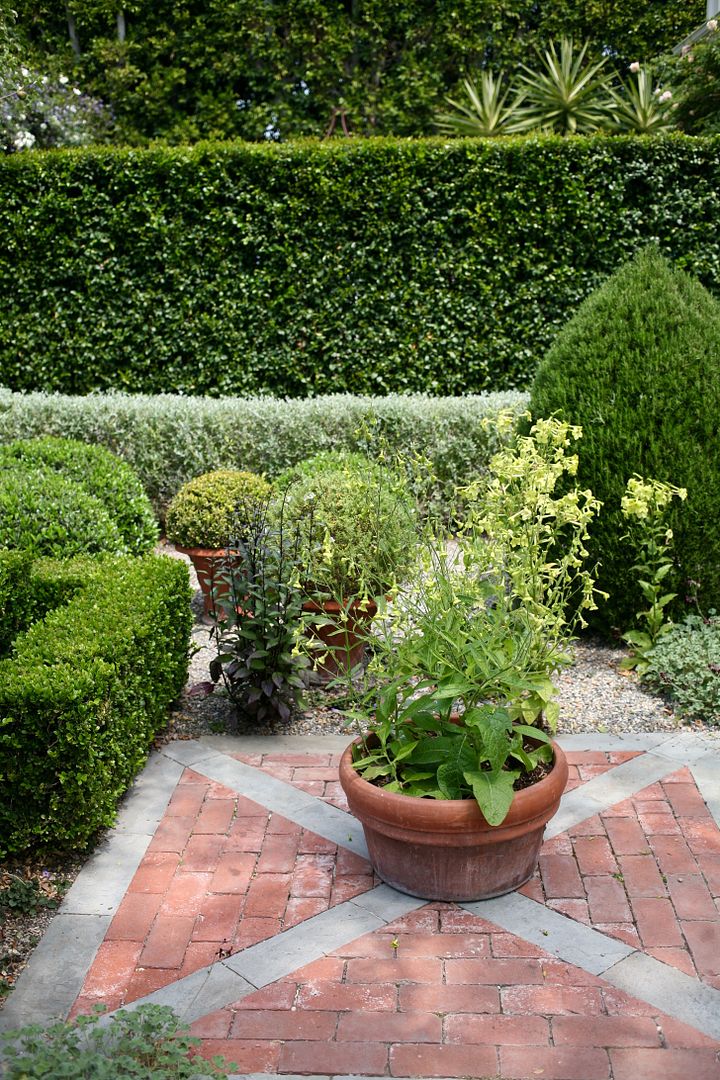
I toured this garden designed by Judy Horton back in May as part of the Garden Conservancy’s Open Days for Los Angeles and recently uncovered just a few photos, not really enough for a proper blog post as far as overall layout and flow. But looking at the photos in late July, I’m struck by how the garden makes the barest nod to spring, choosing instead to enfold its owners in vines, hedges and lacy tree canopies, the OG counterpart to living walls and green roofs inspired by the owner’s childhood in New Orleans. This garden takes the long view, practicing in spring the cool look it will need for a hot summer, a balmy fall, a barely there winter (15 inches of rain in a “normal” year), and so back to spring. Formal gardens, after all, are an ancient design strategy for hot, dry places, dating back to the Egyptians, when it’s thought the genesis of the geometric grid layout began with following the axis of irrigation canals.

It’s a disciplined garden far removed from my own small plant collector’s jumble — but then the portraits that gardens provide of their owners are one of the key pleasures of visiting them. The rigorously clear design intentions hinted to me of a fastidious sensibility that looked outside California for inspiration, and I wanted to know more. (Links provided at end of post). What really fascinates me is that this design, purposely drained of most colors but green, was pondered over a dozen years by the owner, the interior designer Suzanne Rheinstein, and is an aesthetic choice as much as a response to a mediterranean climate: “Part of my garden was inspired by Nicole de Vesian, the head of design at Hermes for many years, who had an extraordinary garden in Provence that I was so fortunate to visit. She used a lot of gravel in her gardens, which was also a perfect solution to gardening in our Southern California climate.” (Nicole de Vesian began her influential garden at the age of 70: “She had a feeling for space just as a musician has a good ear.” Modern Design in Provence by Louisa Jones)

The function of hedges is often viewed as the mute, utilitarian backdrop to floral exuberance, in conciliatory climates like those of England and Holland. As the Sissinghurstian trope goes, formal layout, informal planting. In this summer-dry garden, the importance of hedges is moved from background to foreground, their clipped geometry providing volume, scale, enclosure, and soothing studies of shadows and green. And the cooling abilities, bird cover, and pollutant-trapping powers of all those small leaves are not to be underestimated either. (“Plant hedges to combat near-road pollution exposure.”)


Small panels of lawn surround a small pool with bubbler. Other surfaces are gravel, bluestone, brick.




All quotes from the summer 2011 issue of Flower, found here. The Rheinstein garden is included in Outstanding American Gardens; A Celebration: 25 Years of the Garden Conservancy

I love this. But then I would, as a southerner in an old brick house, brought up with boxwoods, formality, and dark green painted structures.
The garden doesn’t evoke New Orleans for me, because NOLA’s so wet that the fundamental impression is of overgrown-ness — in even the sparest garden there’s the palpable sense of struggle to hold back rampant plants. But that deep porch and upstairs railing give a southern feeling.
As well as the gravel, the tidy, clipped hedges and balls and modest circular pool show the Nicole de Vesian influence. The brick-and-paver squares would be lost, subsidiary detail in a more floral garden; here they’re subtle stars year-round. Great work by Judy Horton.
But what the hell kind of person waits fourteen years to make a garden? No kind of gardener, that’s for sure.
I love the first shot, with the roses cascading down from the upper level of the house. All that green helps the selected floral display stand out nicely. I’ve developed an appreciation for hedges to mark garden perimeters in recent years, although I still can’t get on board on boxwood squares as decorative elements.
I certainly see the appeal of formal gardens like these, and I imagine it has both a psychological and environmental cooling effect. It also doesn’t look worn out and crappy in high summer like my garden. Still, I prefer to live with my horticultural chaos.
The street trees in the neighborhood I grew up in were Chinese Elms. I have always loved them, but I only see them planted occasionally around here.